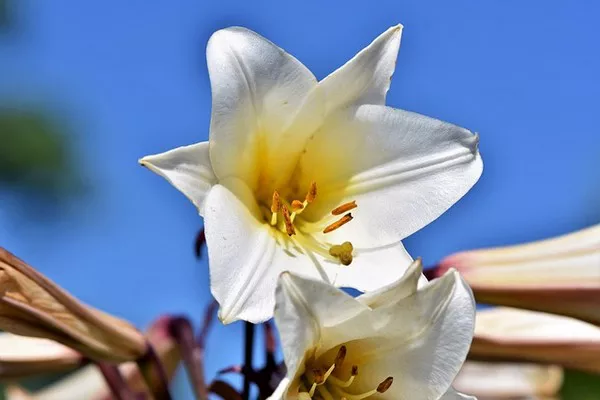Throughout human history, flowers have held a significant place in various cultures as symbols of beauty, love, and emotions. Among these, the lily flower stands out with its exquisite appearance and rich symbolism that transcends cultural boundaries. From ancient civilizations to modern times, the lily has captivated hearts and minds, representing a spectrum of meanings that resonate deeply with human experiences.
See Also: Unveiling the Symbolism& Meaning Behind the Lily Flower
Historical Roots of Lily Symbolism:
The lily’s symbolic significance dates back to ancient times, where it graced the mythology and art of civilizations like the Greeks, Romans, and Egyptians. In Greek mythology, the lily was believed to have sprung from the milk of Hera, the queen of the gods. This association with motherhood and fertility established the lily as a symbol of purity and nurturing.
In Christianity, the Madonna Lily became a prominent motif, representing the Virgin Mary’s purity and her role as the mother of Jesus. Its white petals and golden stamens came to symbolize the conception of Jesus and Mary’s immaculate nature.
Diverse Meanings Across Cultures:
The lily’s significance varies across cultures, often reflecting the values and beliefs of the societies that embrace it. In Chinese culture, the lily represents good luck and abundance. The flower’s elegant form and harmonious colors are admired as symbols of lasting relationships and a prosperous life.
Conversely, in ancient Egyptian culture, the lily was associated with death and rebirth. The blue water lily, known as the “blue lotus,” was connected to the sun and creation. Its emergence from murky waters each morning was seen as a symbol of resurrection, mirroring the sun’s daily journey across the sky.
Lily Varieties and Their Meanings:
Beyond the broad symbolism, different species and colors of lilies convey specific meanings. The most common types include the Calla Lily, Daylily, and Tiger Lily, each carrying its own cultural and emotional connotations.
Calla Lily: Often associated with weddings and elegance, the Calla Lily symbolizes devotion and purity. Its trumpet-shaped form is seen as a representation of heavenly trumpets, adding a spiritual dimension to its symbolism.
Daylily: The Daylily is renowned for its fleeting but beautiful blossoms, representing fleeting emotions and the passage of time. It encourages us to cherish the present moment and embrace change.
Tiger Lily: The bold and vibrant Tiger Lily carries associations of wealth and pride. In Native American cultures, it is a symbol of balance, as its colors combine the opposing forces of fire and water.
Emotional and Personal Symbolism:
On a more personal level, individuals often attribute their own meanings to the lily based on their experiences and emotions. The flower’s graceful appearance and fragrant scent evoke feelings of serenity and renewal, making it a popular choice for bouquets and floral arrangements.
The lily’s role in expressing condolences during times of loss is particularly noteworthy. The flower’s association with death and rebirth lends itself to conveying sympathy and the hope of new beginnings to those who are grieving.
Lilies in Art and Literature:
Artists and writers have long been inspired by the lily’s beauty and symbolism. In visual art, lilies are often depicted in religious paintings, symbolizing purity and transcendence. Writers, too, have woven the lily into their works to convey themes of love, innocence, and transformation. Notably, Oscar Wilde’s poem “The Lilies” uses the flower to explore themes of desire and death.
Modern Interpretations:
In contemporary society, the lily’s symbolism continues to evolve. It has become a symbol of various movements, including those advocating for environmental conservation and gender equality. Its endurance as a potent symbol is a testament to its ability to adapt to changing cultural and societal landscapes.
In Conclusion:
The lily flower’s symbolism is as complex and diverse as the cultures and emotions it represents. From ancient myths to modern interpretations, the lily has maintained its position as a timeless symbol of beauty, purity, renewal, and transformation. Its ability to transcend time and cultures underscores the universal human need for meaningful symbols to express our deepest emotions and experiences. Whether displayed in art, offered as a gift, or admired in a garden, the lily stands as a testament to the enduring power of nature’s beauty and the human spirit’s quest for significance.


